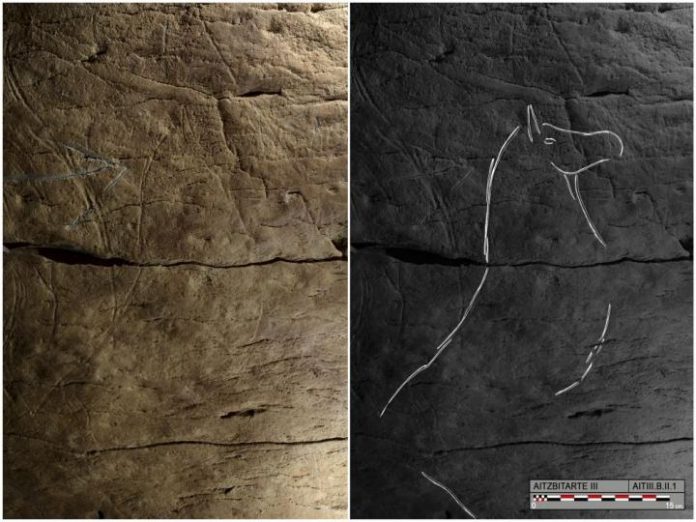
Photo: Photograph and tracing of horse B.II.1, engraved on the right-hand wall in Aitzbitarte Cave III (O. Rivero and D. Garate).
view more
Credit Image: Garate et al, 2020 (PLOS ONE, CC BY)
Recently discovered rock art from caves in Northern Spain represents an artistic cultural style common across ancient Europe, but previously unknown from the Iberian Peninsula, according to a study published October 28, 2020 in the open-access journal PLOS ONE by Diego Garate of the Instituto Internacional de Investigaciones Prehistóricas de Cantabria, Spain, and colleagues.
The history of ancient human art includes various cultural complexes characterized by different artistic styles and conventions. In 2015, new instances of rock art were discovered in three caves in Aitzbitarte Hill in northern Spain, representing an artistic style previously unknown from the Iberian Peninsula. In this study, Garate and colleagues compare this artistic style to others from across Europe.
The artwork in the Aitzbitarte caves consists mostly of engravings of bison, complete with the animals’ characteristic horns and humps. The authors note the particular style in which the animals’ horns and legs are drawn, typically without proper perspective. Pairs of limbs are consistently depicted as a “double Y” with both legs visible, and the horns are similarly draw side-by-side with a series of lines in between.
This is consistent with the artistic style of the Gravettian cultural complex, characterized by specific customs in art, tools, and burial practices between about 34,000 and 24,000 years ago. This culture is known from across Europe but has not been seen before on the Iberian Peninsula. The authors combine this new discovery with data from around Europe to show that the Gravettian culture was more widespread and varied than previously appreciated.
The authors add: “The study analyses the particularities of Palaeolithic animal engravings found in the Aitzbitarte Caves (Basque Country, Spain) in 2016. These prehistoric images, mainly depicting bison, were drawn in a way that has never before been seen in northern Spain; in a kind of fashion in the way of drawing the engravings that is more characteristic of southern France and some parts of the Mediterranean. The study has shown the close regional relationships in Western Europe cave art since very early times, at least, 25,000 years ago.”
###
Video Link: https:/
Citation: Garate D, Rivero O, Rios-Garaizar J, Arriolabengoa M, Intxaurbe I, Salazar S (2020) Redefining shared symbolic networks during the Gravettian in Western Europe: New data from the rock art findings in Aitzbitarte caves (Northern Spain). PLoS ONE 15(10): e0240481. https:/
Funding: The project “Before art: social investment in symbolic expressions during the Upper Palaeolithic in the Iberian Peninsula” (PID2019-107262GB-I00) was funded by the Ministerio de Ciencia, Innovación y Universidades (Spain), PI: Diego Garate. I. Intxaurbe’s PhD research is funded by a grant for the training of research personnel (PIF 2019) at the University of the Basque Country (UPV/EHU). The funders had no role in study design, data collection and analysis, decision to publish, or preparation of the manuscript.
Competing Interests: The authors have declared that no competing interests exist.
In your coverage please use this URL to provide access to the freely available article in PLOS ONE: https:/
TDnews (tunisiesoir.com)















